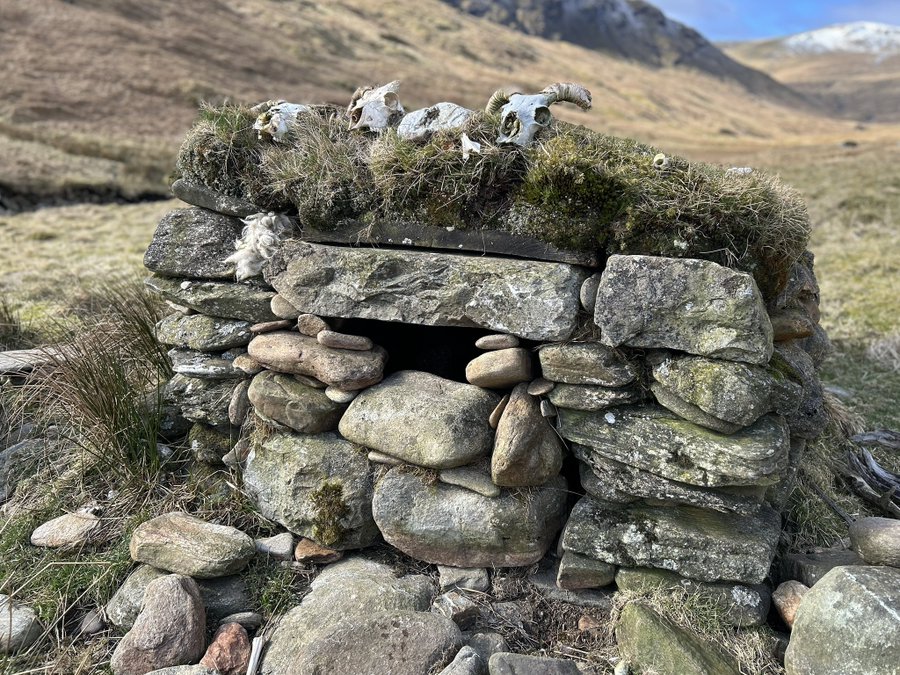The Road Less Travelled – Walking off the beaten track in the Southern Highlands
“To proceed very far through the desert, you must be willing to meet existential suffering and work it through. In order to do this, the attitude toward pain has to change.” Scott Peck
More years ago than I care to remember now, whilst perusing the empty part of an Ordnance Survey map of the Bridge of Orchy area, my eye caught three words written in the medieval script that mapmakers use to denote a man-made structure of some antiquity: Tigh nam Bodach – the house of the old man. What, I asked myself, could this be? It was clearly important enough to get its own Gaelic nomenclature but many miles from any other settlement or structure. The high, craggy hills that encircled Tigh nam Bodach looked as though they huddled around it to form a protective shield. Not quite an impenetrable barrier, but quite enough to deter all but the most committed walker. For years thereafter, whenever I’d unfurl that particular map, Tigh nam Bodach would always catch my eye, as though goading me to visit it.
But I never did. Years passed – decades, even. Though ever-aware of Tigh nam Bodach, I always found a reason to go somewhere else. Some hill, or some other place would call louder. And so for over 30 years, till very recently, the house of the old man remained to me unvisited, unsolved, uncertain.
It was as good a day as one could wish for when I pulled up at the head of Loch Lyon on a beautiful March morning. The sun, though pale and cool at 8 am, was full of promise. An afternoon of pleasant warmth beckoned: the sort that seemed to have been absent from a cold and grey Scotland for months. As I set off on my bike along the estate track that straddled Loch Lyon for its full length, curlews fluted — their calls dancing along the hillside on the soft breeze. It was the perfect send-off and a most welcome omen for finally getting round to paying this place a visit, much later than I should have.
Tigh nam Bodach itself is an enigma. Depending on what books or websites one reads, it is either a modern invention or a pagan shrine that dates back to before Christ was born. Constructed from local boulders, and thatched with grass harvested close by, it is scarcely four foot tall and six foot long. In point of fact, if you didn’t know what you were looking for you would walk past it without giving it a second glance. The only thing that suggests it might be harbouring some secret is the opening on its east side.
And so it was to this structure I arrived on that morning of March 15th, my intention to afterwards complete three adjacent Munros to make the day even more memorable. As expected, the small door to the structure was filled in, save for one large boulder that allowed the investigator to peer in. And there they were: a selection of human-like figurines, hibernating in their mountain fastness, waiting for Beltane when local shepherds would come and liberate them – the Cailleach (the old woman), the Bodach (the old man), and their children – for summer. And at Samhain they would duly be returned by the same shepherds. A proper pagan ritual. Or is it? As stated in the previous paragraph, some people think the whole thing is an elaborate hoax, set up by a one-time resident of the glen to impress visitors. Others think the stones date back centuries, to a time when pagan worship predominated in this once-busy glen.


The truth of the matter is that nobody is now alive who knows for sure. For my part, having now been to this remote place, I find the idea that it’s a bit of a wheeze hard to take. The stones look to be very old indeed, and someone has gone to a lot of trouble to build the house – Tigh nam Bodach – that shelters this petrified family. After a while peering at the stones through the gap, I left the place glad that I’d come, with a feeling that I’d witnessed something old, and a little special.
As I walked south, up the steep and pathless slope of Beinn Mhanach, I periodically looked back to check I wasn’t being followed by the Cailleach or the Bodach. I gained height, weaving through the rocks and streams. Soon, Tigh nam Bodach became little more than a dot on the valley floor as I emerged at last on the summit plateau of Beinn Mhanach. The stone figures eased out of my mind as attention was turned to finding a route to the next Munro: Beinn Achaladair. Once again, the going was pathless and demanding. This, for both me and M. Scott Peck, is where true fulfilment is to be found when on the hill. The struggle when on rough, untracked ground, is tempered by the rewards that it brings: usually in the form of wildlife encounters and lack of homo sapiens. The solitude of the hills is its own reward.
And so the summit of Beinn Achaladair was reached and still not a soul had been seen all day, despite the glorious day’s weather and undoubted popularity of the range. It wasn’t until the third and final peak – Beinn a’ Chreachain – was reached that I spoke to someone, a charming woman with a South African accent. The descent from that hill shortly afterwards down a soft, grassy slope, was joyful.
As I picked up the bike to begin the six-mile trip back to the car, Tigh nam Bodach hoved back into view. This marvellous little oopart had bookended my walk, and I was the happier for it. I was glad too that, just maybe, the ghosts of our ancient past still walk in the forgotten places, waiting to be seen by those of us who prefer the untrodden path.
Backing Bella Caledonia 2025 – a Creative & Arts crowdfunding project


Thanks for that, loved it
Lovely and thought provoking piece.